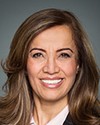Thank you.
I am often asked what I believe the future of politics could look like. In response I tend to think of a historic moment on March 8, 2017, when I took my seat in the House of Commons alongside 336 fellow Daughters of the Vote. I’ll never forget the sense of pride and hope I felt looking at a Parliament filled with women—68 of them indigenous delegates, one of them being the first trans woman to take her seat in the House. I left the chamber with renewed confidence in the capacity of our political institutions to be inclusive and representative, but also aware of the work and commitment it would take to make this a reality.
To understand the underrepresentation of women in Parliament, we need to examine political parties' internal policies mandating the recruitment of diverse female candidates, the context in which these policies are being adopted, and the responsibility parties have in considering the ridings their candidates are running in. In the absence of legislative measures and the lack of formal actions, such as quotas or targets, steps to address gender parity are taken on a voluntary basis by political parties.
The result of the last B.C. election is indicative of the impact that these voluntary measures can have. While one-third of female candidates running were elected, the NDP's self-imposed equity policy resulted in 46% of their elected MLAs being women, compared to the B.C. Liberals' 32%. Federally, the NDP doesn’t run nomination races until it’s demonstrated that efforts have been made to recruit diverse candidates, and has committed to an equity-seeking mandate. The success of this proactive, nomination-based mandate was demonstrated in the 2015 federal election, as 43% of the candidates running for the NDP were women compared to just 31% of Liberals, and less than 20% of Conservatives. This ongoing struggle to recruit female candidates is emblematic of broader structural issues, such as a lack of clarity and transparency in nomination processes. What exactly does it mean to demonstrate efforts to recruit diverse candidates?
To create effective and intentional strategies, political parties need to ask themselves, what needs to happen to get women to opt-in and what does it mean to be qualified for political office? Fox and Lawless have shown that men aged 18-25 are twice as likely to say that they’ve thought about running for office many times, and have been encouraged to do so by others. When women are frequently asked to put their name forward, their likelihood of thinking about running for office increases dramatically. When asked a hypothetical question about whether they’d run for a political position in the future, 51% of young women said no compared to 31% of young men.
In addition, there’s a 30% gap between men and women in thinking that they’re not qualified. While attempting to put together a diverse slate to run in a student election at the University of Victoria, I asked numerous women to run for executive positions, and the responses were, why me? I’m sure there’s someone better than me for this position, and I’ve never thought about running for political office. By contrast, a majority of the men I asked either immediately agreed to run, or declined for reasons unrelated to their ability to hold an executive position.
Even when women run, they are under-represented in winnable ridings. In the 2015 federal election, women running for the Liberals and Conservatives won less frequently than their male colleagues. As the president of the Young Liberals of Canada in B.C., I paid particular attention to the outcome of our last election in which more than half of men running for the provincial Liberal party won their seat, while only 39% of women won theirs. While the gap is smaller in the NDP it still exists. Therefore, putting women in another party’s stronghold is not just a federal or a centre-right issue. A long-term study found that women were less likely to run in their party’s stronghold, less likely to run in competitive ridings, and more likely to run in another party’s stronghold.
The political culture within our institutions creates additional barriers. Politically engaged women encounter gender bias in media representations of female politicians, hear gender-based heckling, and are aware of the whisper network around sexualized violence and harassment. Women, as a result, may be less inclined to run for office. One of the questions that media outlets repeatedly ask women in politics is, how do you balance your family and professional life? The male colleagues, on the other hand, are instead asked about their careers. This perpetuates gender-based assumptions of women’s responsibility as caregivers, while reinforcing the outdated belief that men are naturally acclimatized to the public sphere. The language we use can either reinforce or dismantle pre-conceived ideas, and its impact is clearly demonstrated in the usage of heckling in parliamentary sessions.
A United Nations survey of elected women revealed that women experience daily condescension, including being shushed, told to calm down, and to be nicer. Additionally, research has shown that men heckle more than women, that women are interrupted more than men, and that women are more likely to say they hear heckles based on gender. As a young woman who is actively engaged in politics, I have taken part in numerous political simulations. In these spaces, I have personally been told to be less emotional, had my capacity to be the leader of a party questioned on the basis of my gender, had my intelligence reduced to the colour of my hair, and have consoled countless female colleagues who heard heckles relating to their menstrual cycle and physical appearance. I have watched young women remove themselves from the room who had been facing the aggressive and hurtful nature of heckles, some choosing not to return.
As leaders in our society, we need to be calling out jokes and language that objectify women, as these serve to uphold a structure of sexualized and gender-based violence. Issues of sexualized violence and harassment are pervasive. I know young women staffers who have experienced objectification and violence in their roles, some of whom have been scared to come forward because of the risk to their reputation and their future in politics.
While the federal government and some provinces have created or committed to advancing harassment policies to protect them, legislation alone won't shift a culture of misogyny and abuse. Furthermore, corrective policies also contain problematic elements. For example, Newfoundland and Labrador's harassment policy fails to be survivor centred by stipulating that survivors have 12 months to submit a complaint and may not do so anonymously.
While we have a long way to go in creating safe and inclusive environments for women in politics, mentorship opportunities can provide a counterweight to gender dynamics in political spaces.
In my experience as a board member and participant in the Canadian Women Voters Congress campaign school, I have witnessed the impact of creating non-partisan spaces for women to network and to support each other. It is within these collaborative spaces that women mentor each other and encourage each other to run for office, where gender dynamics are discussed, strategies for challenging derogatory comments are advanced, and where worries about subjective political competence are quelled.
However, normally underfunded, under-staffed organizations create these opportunities. Therefore I believe we should be simultaneously overlapping female mentorship with existing youth programs and events like model parliaments to continue counteracting our current political culture and to encourage more women to opt into politics.
Thank you for allowing me to be here today, and I look forward to any of the questions you may have for me.



